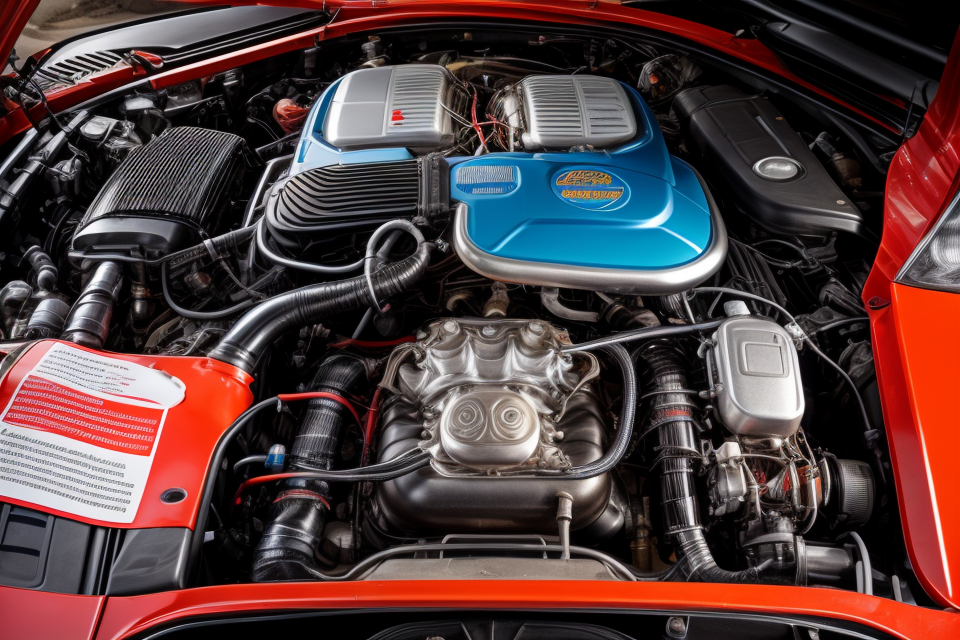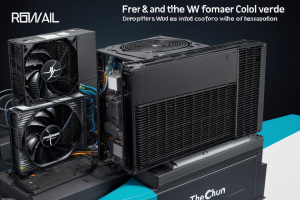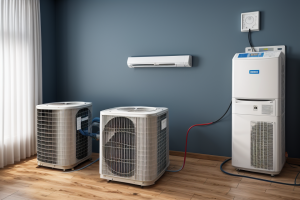
Your car’s engine is like the heart of your vehicle, and just like how your heart needs to be healthy for you to function, your car’s engine needs to be in good condition for your vehicle to run smoothly. One crucial aspect of engine health is the engine cooling system. Without a properly functioning cooling system, your engine can overheat, leading to costly repairs or even total engine failure. In this article, we will explore the common causes of engine cooling system failure and provide you with valuable tips on how to prevent it. So, buckle up and let’s dive in!
Engine cooling system failure can be caused by a variety of factors, including leaks in the cooling system, a malfunctioning thermostat, or a clogged radiator. To prevent engine cooling system failure, it is important to regularly check the coolant level and condition, as well as the condition of the hoses and belts. It is also important to change the coolant according to the manufacturer’s recommendations and to have the cooling system inspected and serviced by a qualified mechanic as needed.
Causes of engine cooling system failure
Overheating
Overheating is a common cause of engine cooling system failure. It occurs when the engine’s temperature rises above the normal operating range, causing damage to the engine components. There are several causes of overheating in an engine, including:
Causes of overheating
- Lack of coolant: If the coolant level in the engine is low, it can cause overheating. The coolant helps to transfer heat away from the engine, and if there is not enough coolant, the engine’s temperature can rise.
- Faulty thermostat: The thermostat regulates the flow of coolant through the engine, and if it is faulty, it can cause the engine to overheat.
- Faulty water pump: The water pump is responsible for circulating coolant through the engine, and if it is faulty, it can cause the engine to overheat.
- Clogged radiator: The radiator is responsible for cooling the engine, and if it is clogged, it can prevent the coolant from flowing properly, causing the engine to overheat.
Symptoms of overheating
- The temperature gauge on the dashboard reads high
- Steam or smoke coming from under the hood
- The engine is making strange noises
- The engine is running rough or stalling
Consequences of overheating
- Engine damage: Overheating can cause damage to the engine, including warping or cracking of the cylinder heads, and blowing of the head gasket.
- Cooling system damage: Overheating can cause damage to the radiator, hoses, and other components of the cooling system.
- Reduced engine lifespan: Overheating can reduce the lifespan of the engine, leading to costly repairs or even the need for a replacement engine.
To prevent overheating, it is important to regularly check the coolant level, replace the thermostat and water pump as needed, and keep the radiator clean. Additionally, it is important to follow the manufacturer’s guidelines for regular maintenance and service of the engine and cooling system.
Leaking or faulty coolant system
Causes of leaking or faulty coolant system
A leaking or faulty coolant system can be caused by a variety of factors, including:
- Damaged or corroded hoses
- Cracked or warped engine blocks or cylinder heads
- Worn or damaged water pump
- Defective thermostat
- Malfunctioning radiator cap
Symptoms of leaking or faulty coolant system
Some common symptoms of a leaking or faulty coolant system include:
- Coolant leaks on the ground beneath the vehicle
- Overheating engine
- Low coolant levels
- Steam or smoke from under the hood
- Diluted coolant color
Consequences of leaking or faulty coolant system
If a coolant system is leaking or faulty, it can lead to a number of serious consequences, including:
- Engine overheating and failure
- Cooling system corrosion
- Reduced fuel efficiency
- Damage to other engine components
- Increased emissions and potential for engine damage.
Faulty thermostat
A faulty thermostat can cause a number of issues with the engine’s cooling system.
Causes of faulty thermostat
The primary cause of a faulty thermostat is wear and tear over time. The thermostat can become dirty or gummed up with debris, which can cause it to malfunction. In some cases, the thermostat may be installed incorrectly, which can also cause it to fail.
Symptoms of faulty thermostat
If the thermostat is not working properly, the engine may overheat or run too cold. The temperature gauge may fluctuate or read incorrectly, and the engine may take longer to warm up or cool down.
Consequences of faulty thermostat
A faulty thermostat can cause serious damage to the engine if left unchecked. Overheating can cause the engine to seize up or even catch fire, while running too cold can cause the engine to wear down more quickly and potentially fail. Additionally, a faulty thermostat can reduce the overall efficiency of the engine, leading to decreased fuel economy and performance.
Faulty water pump
The water pump is a critical component of the engine’s cooling system. It is responsible for circulating coolant throughout the engine, removing heat generated by the combustion process. A faulty water pump can cause a variety of problems, ranging from overheating to engine failure.
Causes of faulty water pump
There are several reasons why a water pump may fail, including:
- Wear and tear: Over time, the water pump’s bearings and seals can wear out, causing it to fail.
- Coolant leaks: If the coolant system is leaking, the water pump may not be able to circulate enough coolant to keep the engine cool, leading to overheating.
- Debris: Debris from the engine or coolant system can clog the water pump’s impeller, preventing it from functioning properly.
Symptoms of faulty water pump
Some common symptoms of a faulty water pump include:
- Overheating: If the water pump is not circulating enough coolant, the engine may overheat, causing damage to the engine and other components.
- Radiator cap pressure release: If the water pump is failing, the radiator cap may release pressure, indicating that the cooling system is not functioning properly.
- Coolant leaks: If the water pump is leaking, coolant may accumulate under the vehicle, indicating a problem with the water pump.
Consequences of faulty water pump
If a water pump fails, it can lead to several consequences, including:
- Engine damage: If the engine overheats, it can cause damage to the engine and other components, potentially resulting in costly repairs.
- Reduced fuel efficiency: A faulty water pump can reduce the engine’s fuel efficiency, leading to increased fuel consumption and higher operating costs.
- Engine stalling: If the water pump fails completely, it can cause the engine to stall, leaving the vehicle stranded.
Preventing water pump failure requires regular maintenance and inspection of the cooling system. This includes checking the coolant level, inspecting the hoses and belts, and ensuring that the water pump is functioning properly. By taking these steps, drivers can help prevent engine cooling system failure and keep their vehicles running smoothly.
Radiator issues
Causes of radiator issues
The radiator is responsible for dissipating heat from the engine, and it is critical for maintaining the engine’s temperature. Radiator issues can arise due to various reasons, including:
- Low coolant level: If the coolant level in the radiator is low, it can lead to insufficient cooling, which can cause engine overheating and eventually damage the engine.
- Faulty water pump: The water pump is responsible for circulating coolant through the engine and radiator. If the water pump fails, the coolant may not circulate properly, leading to overheating.
- Damaged thermostat: The thermostat regulates the flow of coolant through the engine and radiator. If the thermostat is damaged, it may not allow the coolant to flow properly, leading to overheating.
- Debris or clogged radiator: Debris, such as dirt, rust, or other debris, can clog the radiator, preventing the coolant from flowing properly and causing overheating.
Symptoms of radiator issues
The symptoms of radiator issues can include:
- Overheating: If the engine is overheating, it may be a sign that the radiator is not functioning properly.
- Low coolant level: If the coolant level in the radiator is low, it may indicate a leak or damage to the radiator.
- Steam or smoke from the engine: If there is steam or smoke coming from the engine, it may indicate a serious problem with the radiator or cooling system.
Consequences of radiator issues
The consequences of radiator issues can be severe and may lead to engine damage or even a complete engine failure. Some of the potential consequences include:
- Engine overheating: If the engine overheats, it can cause damage to the engine, including warping or cracking of the engine blocks, which can be expensive to repair.
- Loss of coolant: If there is a leak or damage to the radiator, the engine may lose coolant, which can lead to further damage to the engine or other components.
- Engine failure: If the engine overheats for an extended period, it can lead to complete engine failure, which can be expensive to repair or require a replacement engine.
In conclusion, radiator issues can cause engine cooling system failure, and it is essential to address these issues promptly to prevent further damage to the engine. Regular maintenance and inspection of the radiator and cooling system can help prevent radiator issues and ensure that the engine remains cool and efficient.
Preventing engine cooling system failure
Regular maintenance
Cooling system inspection
One of the most critical aspects of preventing engine cooling system failure is to regularly inspect the entire cooling system. This includes checking for any leaks, corrosion, or damage to the radiator, hoses, water pump, and other components. A thorough inspection should be performed at least once a year, or more frequently if the vehicle is used heavily or driven in extreme conditions.
Fluid level check
The cooling system in your vehicle relies on a mixture of water and antifreeze to keep the engine cool. It is essential to check the fluid level regularly and top it off if necessary. Over time, the cooling system can lose fluid due to leaks or evaporation, which can lead to engine overheating and eventual failure. A good rule of thumb is to check the fluid level every 30,000 miles or so, or more frequently if the vehicle is driven in dusty or muddy conditions.
Thermostat inspection
The thermostat is a critical component of the engine cooling system, as it regulates the flow of coolant through the engine. A malfunctioning thermostat can cause the engine to overheat or run too cold, which can lead to failure. It is important to inspect the thermostat regularly and replace it if necessary. A thermostat that is not functioning properly can cause damage to the engine and other components of the cooling system.
Radiator cap inspection
The radiator cap is responsible for maintaining the pressure in the cooling system and preventing the coolant from boiling over. A worn or damaged radiator cap can cause the engine to overheat, which can lead to failure. It is important to inspect the radiator cap regularly and replace it if necessary. A faulty radiator cap can cause the engine to run too hot, which can lead to damage to the engine and other components of the cooling system.
Proper operation of the cooling system
Ensuring proper coolant levels
Maintaining the correct coolant level in the engine’s cooling system is essential to prevent failure. Overfilling or underfilling the system can cause problems. To check the coolant level, inspect the overflow tank, and make sure the level is within the specified range.
Avoiding overheating
Overheating is one of the primary causes of engine cooling system failure. It can cause the engine to seize, leading to costly repairs. To prevent overheating, regularly check the coolant temperature gauge and maintain it within the recommended range.
Using correct coolant type
Using the correct coolant type is crucial to prevent damage to the engine and cooling system. Using the wrong type of coolant can cause corrosion, which can lead to failure. Always refer to the manufacturer’s recommendations for the correct coolant type for your vehicle.
Using correct coolant concentration
Maintaining the correct coolant concentration is essential to prevent corrosion and protect the engine from damage. Too little coolant can cause the system to freeze, while too much coolant can cause corrosion. Refer to the manufacturer’s recommendations for the correct coolant concentration and follow the guidelines for mixing or topping off the coolant.
Addressing potential issues early
When it comes to preventing engine cooling system failure, one of the most effective strategies is to address potential issues early on. This can be achieved by regularly monitoring cooling system components and taking prompt action on any symptoms that may arise.
Monitoring cooling system components is crucial in ensuring that everything is functioning as it should. This includes checking the coolant level, the condition of the radiator, and the functioning of the water pump. By regularly inspecting these components, you can catch any issues before they become serious problems.
It is also important to take prompt action on any symptoms that may arise. For example, if you notice that your engine is overheating, it is essential to take action immediately. This may involve checking the coolant level, inspecting the radiator, or even replacing a faulty component.
Seeking professional assistance when needed is also a crucial part of preventing engine cooling system failure. A mechanic can provide a thorough inspection of your engine and cooling system, and can identify any potential issues before they become serious problems. They can also provide advice on how to maintain your engine and cooling system, helping to prolong its lifespan.
In summary, addressing potential issues early is a key strategy in preventing engine cooling system failure. By regularly monitoring cooling system components, taking prompt action on symptoms, and seeking professional assistance when needed, you can help to ensure that your engine and cooling system remain in good working order.
FAQs
1. What is an engine cooling system and why is it important?
An engine cooling system is a set of components that work together to keep the engine of a vehicle at a safe operating temperature. The system includes a radiator, a water pump, a thermostat, a cooling fan, and a coolant. The cooling system is important because it helps to prevent engine overheating, which can cause serious damage to the engine and other components.
2. What are the common causes of engine cooling system failure?
There are several causes of engine cooling system failure, including leaks in the cooling system, a malfunctioning water pump, a faulty thermostat, and a clogged radiator. Other causes include a low coolant level, a malfunctioning cooling fan, and a damaged radiator cap.
3. How can I prevent engine cooling system failure?
To prevent engine cooling system failure, it is important to regularly check the coolant level and to top it off as needed. It is also important to keep the cooling system clean and to replace the coolant at regular intervals. Other preventative maintenance tasks include checking the water pump and thermostat for wear, and making sure the cooling fan is functioning properly.
4. What are the signs of engine cooling system failure?
The signs of engine cooling system failure include overheating, steam coming from under the hood, and the engine temperature gauge showing high temperatures. Other signs include coolant leaks, a milky white color in the oil, and the engine suddenly losing power.
5. How do I diagnose and fix engine cooling system failure?
To diagnose and fix engine cooling system failure, it is important to first check the coolant level and look for any leaks or damage to the system. If the issue is not apparent, it may be necessary to use a diagnostic tool to check for any electrical or mechanical issues. Once the cause of the failure has been identified, the appropriate repairs can be made.







